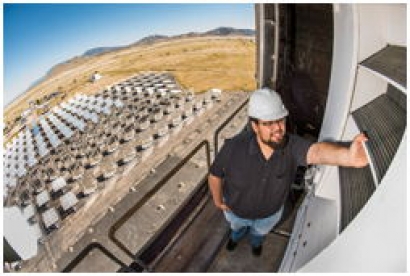
The receivers were designed and studied as part of a Laboratory Directed Research and Development project and are also being applied to Sandia’s work for the Solar Energy Research Institute for India and the United States, or SERIIUS.
SERIIUS is a five-year project co-led by the Indian Institute of Science and the National Renewable Energy Laboratory, sponsored by the U.S. Department of Energy and the government of India that aims to develop and improve cost effective solar technology for both countries.
The research is aimed at Improving the efficiency of more compact receiver designs to enable development of small concentrating solar power facilities of 1 MW or less. These could provide the appropriate amount of power for a small village or community
Sandia engineers developed and tested the new receivers at the National Solar Thermal Testing Facility, studying their ability to withstand high temperatures and pressures while absorbing sunlight as heat that can be stored or transferred to a power cycle to generate electricity.
At Sandia’s facility, rows of mirror-like heliostats reflect and concentrate sunlight on a receiver which absorbs the heat and transfers it to gas flowing through the receiver’s paneling. The gas can be used to produce electricity or used with a storage system to be saved for on-demand electricity production when the sun is not shining.
Conventional receiver designs feature a flat panel of tubes or tubes arranged in a cylinder. These designs can absorb about 80 to 90 percent of the concentrated sunlight directed at them. Design improvements can make the receivers even more efficient and help reduce the cost of concentrating solar power and improve scalability.
“When light is reflected off of a flat surface, it’s gone,” said Clifford Ho, Acting Manager, R&D S&E, Mechanical Engineering. “On a flat receiver design, 5 percent or more of the concentrated sunlight reflects away. So we configured the panels of tubes in a radial or louvered pattern that traps the light at different scales. We wanted the light to reflect, and then reflect again toward the interior of the receiver and get absorbed, sort of like the walls of a sound-proof room.”
Previous research on improving efficiency has focused on special coatings applied to the receiver. However, many of these coatings are susceptible to breaking down over time, reducing the ability of the receiver to absorb sunlight. Sandia’s new fractal-like receiver designs have increased solar absorption efficiency without the need for special coatings.
The research team developed and tested multiple prototype fractal-like receiver designs scaled in size to work at small- and medium-scale concentrating solar facilities and found the designs that work best for each application.
The small-scale receiver can be 3D printed using Iconel 718, a high-temperature nickel alloy, providing a cost-effective way to test multiple fractal designs at a small scale. The technique could be used in the future to print entire sections of larger solar receivers.
“Additive manufacturing enabled us to generate complex geometries for the receiver tubes in a small-scale prototype,” Ho said.
The new designs work with conventional heat-transfer fluids for concentrating solar power, including molten salts and steam, but they can also use other media for heat transfer and storage.
Year-round Sandia National Laboratories intern Jesus Ortega inspects one of the new bladed receivers at Sandia’s National Solar Thermal Testing Facility. (Photo by Randy Montoya)

